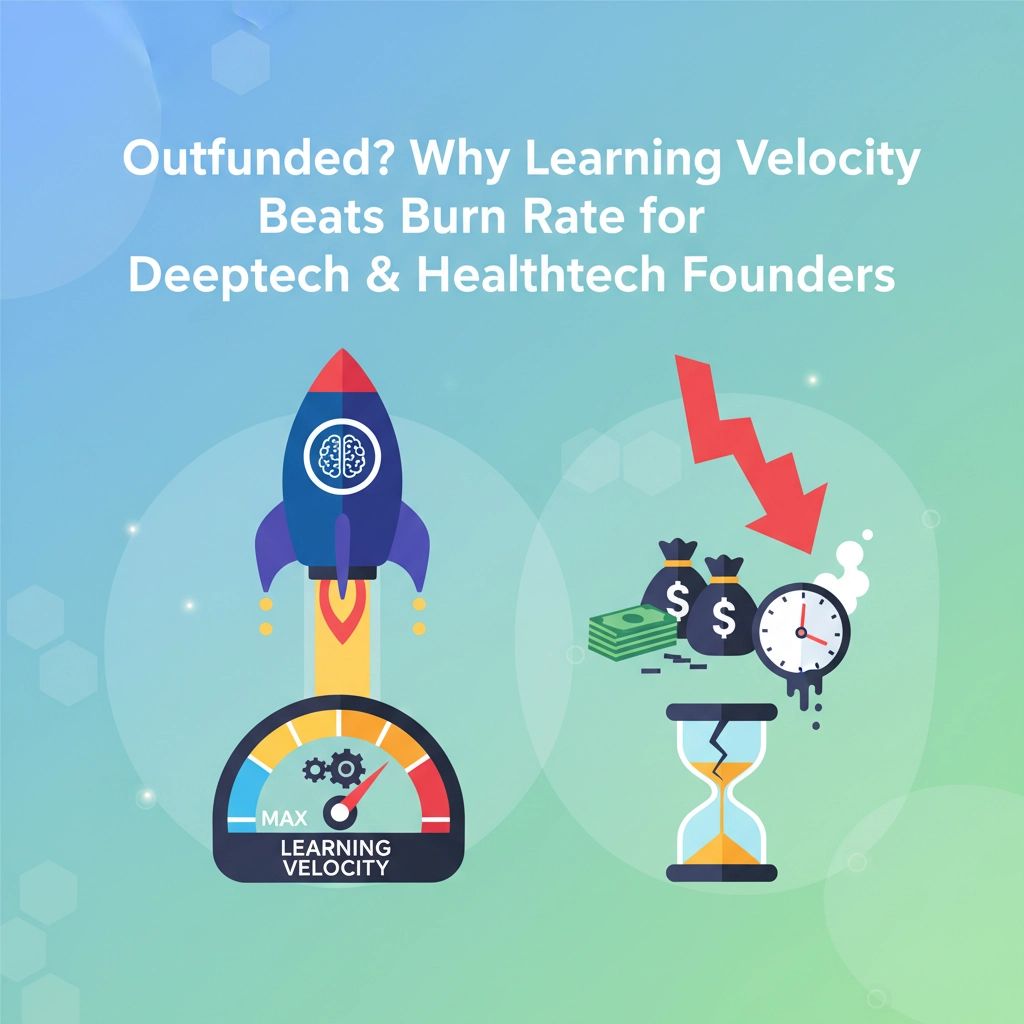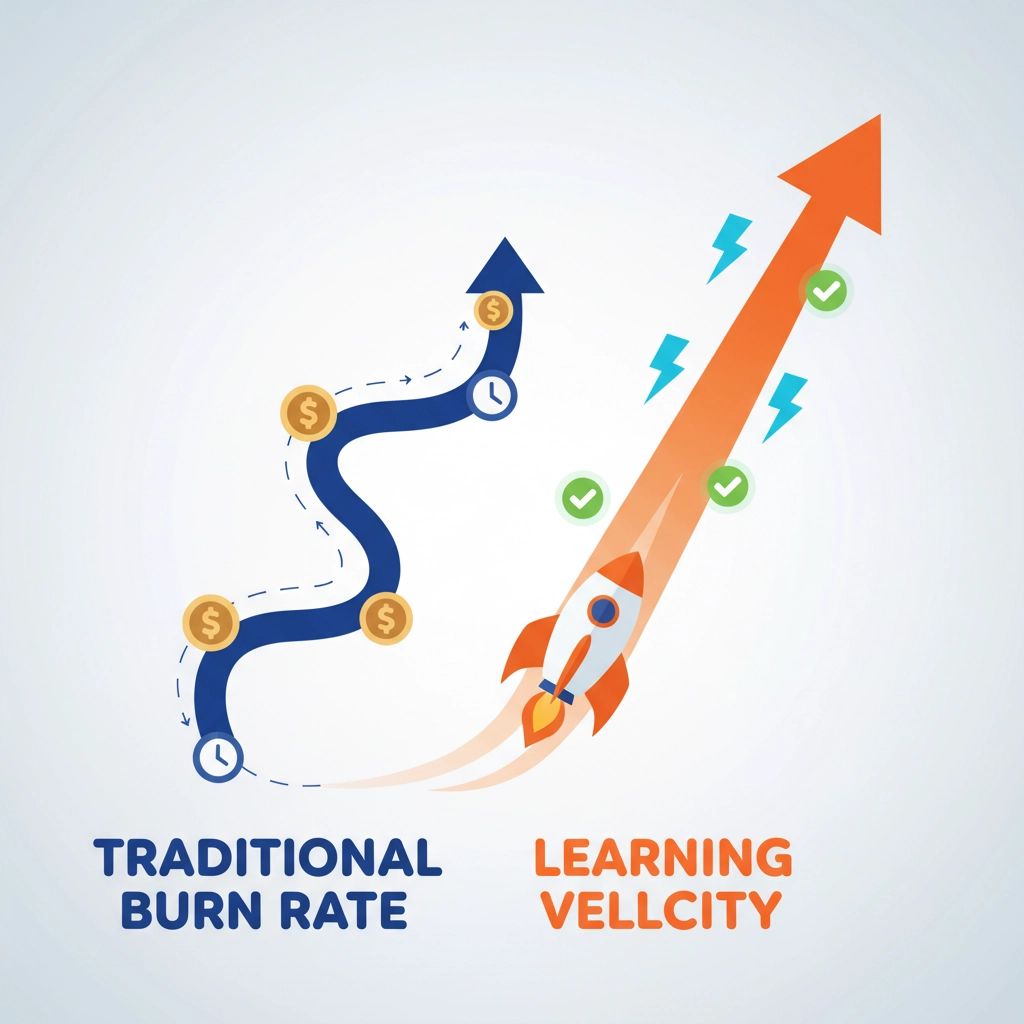Outfunded? Why Learning Velocity Beats Burn Rate for Deeptech & Healthtech Founders
Oct 09, 2025
Most deeptech and healthtech founders walk into investor meetings armed with burn rate projections and runway calculations. Meanwhile, their better-funded peers are talking about something entirely different: how fast they're learning.
While you're explaining why your $2M will last 18 months, the founder who just raised $5M is showing evidence of compressed development cycles, accelerated regulatory processes, and systematic risk reduction. They're not talking about survival, they're demonstrating momentum.
The difference? Learning velocity. And in sectors where development takes years and regulatory hurdles are the norm, investors care far more about your rate of progress than your rate of spending.
What Learning Velocity Actually Looks Like
Learning velocity isn't startup buzzword bingo. It's measurable progress on the critical unknowns that determine whether your company succeeds or fails. For deeptech founders, that might mean systematically proving technical feasibility milestones ahead of schedule. For healthtech founders, it could be accelerating patient recruitment or streamlining regulatory submissions.
Here's what strong learning velocity looks like in practice:
Cycle Time Compression: You're moving from hypothesis to validated insight faster each quarter. A healthtech startup might reduce their clinical pilot cycle from 6 months to 4 months to 3 months as they refine their processes. A deeptech company might cut their prototype iteration time from 8 weeks to 4 weeks through better experimental design.
Evidence Pack Development: Every 90 days, you have new proof points that reduce investor risk. This isn't just revenue growth: it's regulatory pre-submissions, pilot program results, partnership letters of intent, or technical milestone completion.
Strategic Optionality: Your rapid learning creates multiple paths forward rather than betting everything on one approach. You're discovering adjacent markets, alternative regulatory pathways, or partnership opportunities that compound your chances of success.

Why Traditional Metrics Miss the Mark
Burn rate tells investors you can survive 18 months. Learning velocity tells them you'll be a different company in 6 months: ideally, a less risky one with clearer commercial prospects.
This distinction becomes critical in deeptech and healthtech because these sectors have structural differences from typical software startups. Healthcare companies face longer profitability timelines, complex reimbursement landscapes, and regulatory approval processes that can take years. Deeptech companies often require significant upfront R&D investment before any revenue materializes.
In these environments, investors aren't looking for lean startup efficiency: they're seeking evidence of systematic progress toward overcoming sector-specific obstacles. They want to know you can navigate complexity, not just stretch dollars.
Consider the deeptech founder who shows investors how they've compressed their material testing cycles from 12 weeks to 6 weeks while improving accuracy. Compare that to the founder who proudly shows 15% lower operational costs. The first founder demonstrates they can accelerate toward product-market fit. The second just shows they can fail more slowly.
The Investor Psychology Behind Learning Velocity
When investors evaluate deeptech and healthtech companies, they're making bets on execution capability under uncertainty. These sectors are littered with brilliant technologies that never found their market, regulatory strategies that stalled in bureaucracy, and technical solutions that couldn't scale economically.
Learning velocity signals something crucial: you can iterate your way out of trouble. You're not just executing a predetermined plan: you're actively discovering the path to commercial success and adapting your strategy based on evidence.
This matters because venture capital fundamentals remain the same across all sectors: investors need asymmetric returns through pattern recognition. When they see a founder consistently hitting milestones ahead of schedule, adapting quickly from customer feedback, and building strategic advantages at speed, it triggers the critical insight: "This team can execute in uncertainty."

Building Your Learning Velocity Engine
Strong learning velocity doesn't happen by accident. It requires systematic approaches to experimentation, measurement, and iteration. Here are the frameworks that separate fast-learning founders from those stuck in development cycles:
The 30-60-90 Rule: Structure your activities so you get meaningful feedback every 30 days, validate or pivot assumptions every 60 days, and demonstrate measurable progress every 90 days. For healthtech, this might mean monthly patient interviews, quarterly pilot program metrics, and 90-day regulatory milestone updates. For deeptech, it could be monthly prototype testing, quarterly technical validations, and 90-day commercial feasibility assessments.
Risk-Weighted Roadmaps: Instead of feature roadmaps, build risk reduction roadmaps. Identify the 3-5 biggest assumptions that could kill your company and systematically test them in order of importance. A medical device company might prioritize clinical efficacy, then regulatory pathway, then reimbursement strategy. A deeptech materials company might focus on manufacturing scalability, then cost targets, then market adoption barriers.
Evidence Compounding: Design experiments so early results inform later experiments. Your first clinical pilot shouldn't just prove efficacy: it should generate insights about patient selection, outcome measurement, and implementation challenges that accelerate your next study. Your first customer deployment shouldn't just demonstrate your technology works: it should reveal integration requirements, support needs, and expansion opportunities.
What Investors Actually Want to See
When you walk into your next investor meeting, don't lead with your burn rate calculation. Lead with your learning velocity evidence from the past 90 days. Specifically:
Milestone Compression: Show concrete examples of hitting goals ahead of schedule. "We projected 6 months for regulatory pre-submission and completed it in 4 months while improving our submission quality."
Iteration Speed: Demonstrate faster decision-making cycles. "We reduced our customer validation cycle from 8 weeks to 3 weeks, allowing us to test 4x more assumptions per quarter."
Strategic Insights: Share discoveries that create competitive advantages. "Our pilot program revealed an adjacent market opportunity worth $200M that our competitors haven't identified."
Risk Mitigation: Provide evidence of systematic uncertainty reduction. "We've eliminated 3 of our 5 major technical risks and have clear experimental paths for the remaining 2."

The Compounding Effect of Learning Speed
Learning velocity creates a compounding advantage that extends far beyond fundraising. Fast-learning companies attract better talent because engineers and scientists want to work on projects that make rapid progress. They build stronger partnerships because potential collaborators see momentum and execution capability. They create intellectual property faster because they're iterating through more potential innovations.
Most importantly, learning velocity becomes self-reinforcing. As you get better at rapid experimentation and iteration, you develop institutional knowledge about what works in your specific market. You build processes, relationships, and insights that make future learning even faster.
This compounding effect explains why some deeptech and healthtech companies seem to consistently outpace competitors despite similar resources. They're not just executing faster: they're learning faster, which enables them to execute better.
Making Learning Velocity Your Funding Advantage
The funding landscape for deeptech and healthtech remains challenging. Traditional VCs often lack the expertise to evaluate complex technologies, and sector-specific investors have limited capital compared to general tech funds. In this constrained environment, demonstrating learning velocity becomes a crucial differentiator.
Instead of competing on burn rate efficiency: a race to the bottom: you're competing on execution speed and strategic insight generation. You're showing investors that limited capital in your hands will generate maximum progress toward commercial validation.
The message becomes: "While our competitors are still figuring out their first pilot program, we've already completed three iterations and discovered the optimal implementation approach." That's the kind of momentum that gets investors excited about writing checks.
Learning velocity transforms your narrative from survival ("We can make this money last 18 months") to momentum ("We're systematically proving commercial viability faster than anyone expected"). In sectors where development timelines are measured in years, that transformation often makes the difference between securing funding and remaining indefinitely bootstrapped.
For deeptech and healthtech founders, the question isn't whether you can afford to focus on learning velocity( it's whether you can afford not to.)
